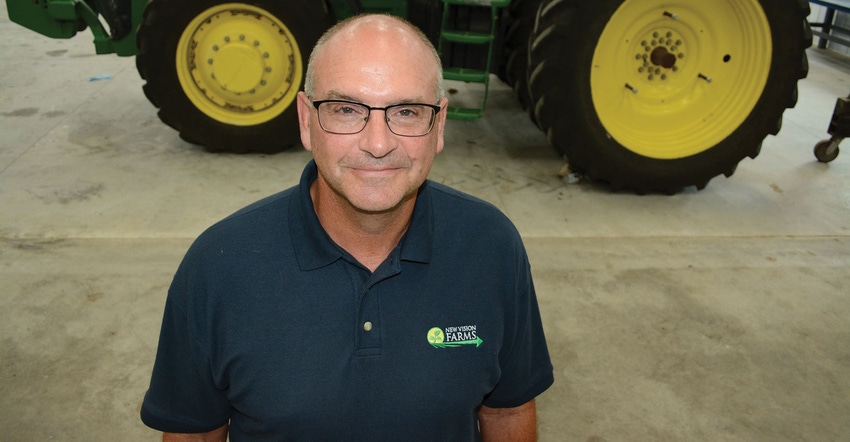
In part one of our series, we shared how farmers are working together to solve machinery, labor and other key management problems. From high production costs to labor scarcity, collaboration with neighboring farms is a way to solve several nagging problems.
But is it for you?
The most obvious challenge is control — who is responsible for decisions?
“The first question most farmers ask is, ‘But who gets to plant, harvest, first?’ You solve that issue right upfront by picking the people who you can work with,” says Chris Barron, an Iowa farmer who works with eight other operations, with a single line of equipment owned by two families. “You can probably find more people you can’t collaborate with. The art is finding the right people.”
Rob Rettig, who also collaborates with two other farmers in Ohio, agrees. “Farmers are by nature independent,” he says. “Our three families were willing to trade independence for interdependence.”
Multi-partner farms have written plans and designated people to run planters, handle seed, handle tillage and other tasks; they have backup plans for when people go missing. Everyone gets cross-training.
Another challenge is bookkeeping. Information tracking is critical. Likewise, leadership. You find out that some people don’t want to make decisions, and you pass that decision-making to someone else.
“There are two different leadership styles,” Barron says. “One guy shows up and says, ‘This is how it’s done’; another is the guy who asks for input, but keeps the gears moving. The first guy is a lot harder to collaborate with.”
Tips to get started
Start by discussing the idea with family, partners, your CPA and attorney, and lenders — get them all on the same page. Can your CPA handle these different business structures, or moving your equipment over to a limited liability company, for example?
You can collaborate on several levels, but you want to go slow and take it one step at a time. “Don’t go all in, all at once,” Barron says. “That’s what causes these arrangements to blow up.”
First, gather potential partners and have a conversation about marketing and purchasing decisions. Maybe you consider combining bushels to sell. After a few of these meetings, you start to see if you think alike.
“One of the most important things we did early on was to have a consultant do personality testing and training,” Rettig says. “It helped each person understand themselves better and relate better to each other. It helped us understand each other.”
Be sure communication is honest and robust, Barron says. “Some people will never go any deeper than that first marketing meeting; you’re dating but not marrying.”
In his group everybody markets his own grain with the option to comingle for volume benefits.
Next, consider management and purchases together. If that works well, go on to equipment pooling — that’s where the biggest economic advantages can be found.
“There are tax opportunities here, but if you go into a collaboration with equipment sharing as the primary focus, you’ll probably break up in five years,” Barron says. “You need to first develop an operating agreement, exit strategy, and figure out how well you can work together.”
If you get this far, next consider a total management consolidation: sharing equipment and all decisions together. Eventually, land comes into play. “When land comes up for sale, we talk first, so we don’t bid against each other,” Barron says.
What’s the structure look like? On top is management, responsible for planning, purchasing and marketing. There are two boxes below that: an equipment LLC and trucking LLC. Below that you may have cash grain, cattle and other entities.
In the equipment LLC, ownership is a choice of those collaborating. You can set up per-acre fees based on equipment company costs, plus a 5% to 12% return. Rates include principal, interest, repair, fuel, labor and insurance. Invoices include labor credit back to participant owner at $15 to $30 per hour. You would have one spring and one fall invoice, for example.
“The equipment angle is where this really shines,” he says. “If you’re one of the partners you can save working capital, and get credit back for your labor,” Barron says.
One way to solve the problem of decision-making and communication is to set up committees for equipment, crop protection and financial decisions, and then have committees report to the whole group. Then not everyone has to be involved in every decision. “There must be trust that these folks are doing their best work,” Barron says.
What makes this business model work? For starters, documentation and transparency. You must have trust with each other, along with a similar vision, for the long-term success of the operation. You need a one-operation mindset. You need diversity of talent and competencies, along with strong harmonic leadership. And you have a written exit strategy with a robust buy-sell agreement.
“In a good situation, you need to self-report and own up to mistakes,” Barron says. “You need a similar vision for the farm. In a collaborative effort, it’s we, not I.”
Make sure you share core values, Rettig adds. “Maybe you start with a strategic alliance first. Be sure it helps everyone; then everyone will be happy. It is a great way to grow and not tie up working capital.”
This process takes time, so go slow at first, Barron concludes. “But the more you manage this, the more opportunities for growth this will bring you.”
Contact Barron at [email protected]; contact Rettig at [email protected].
Related content: 5 ways collaboration can solve key farm business problems.
About the Author(s)
You May Also Like






